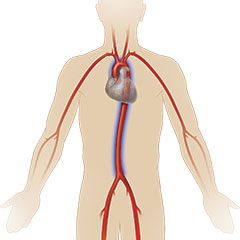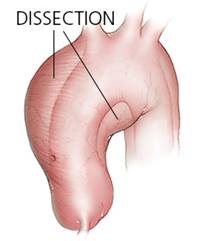An aortic dissection is a life-threatening event. In this condition, the walls of the aorta tear and separate, forming a "false" channel within the aorta. This usually occurs suddenly and is associated with severe, unrelenting pain in the chest, back, or belly.
Aortic dissection can cause inadequate blood supply to the heart, brain, or other major organs. The aorta is substantially weakened and can rupture, resulting in death.
A patient with aortic dissection requires immediate transfer to an experienced surgical center.
The image below shows the aorta, the largest artery in the body that carries blood from the heart to your brain and major organs.

The next image shows a close up view of an aortic dissection that is thoracic (in the chest) and ascending (just above the heart). You can see the layers of the aortic wall have separated and filled with blood.

Aortic dissection may be caused by the following conditions:
- Aortic aneurysm
- High blood pressure
- Coronary artery disease (atherosclerosis or clogged arteries)
- Bicuspid aortic valve
- Connective tissue disorders (including Marfan syndrome)
Diagnostic Tests for Aortic Dissection
Doctors can often identify aortic dissections by symptoms of sudden severe pain in the chest, back or belly. The doctor will also order one of the imaging tests listed below to confirm the diagnosis:
-
CT (Computerized Tomography) Scan
This test creates very detailed images of the heart and aorta. The CT scanner takes many pictures from different angles by rotating an X-ray tube around the body.
-
MRI (Magnetic Resonance Imaging)
During an MRI, you lie in a chamber surrounded by a magnetic field. The magnetic force triggers signals from your body’s tissues that a computer then records. The computer uses these recordings to produce high-quality images of your heart and aorta.
-
Transesophageal Echocardiogram (TEE)
This test is a type of ultrasound done through your throat. The doctor will numb your throat and guide a transducer (a small wand that emits sound waves) into your esophagus until it rests directly behind your heart. From this position, the transducer can obtain high-quality images of your heart and aorta from all sides.
Genetic Testing
If aortic dissections run in your family, it is important to tell your doctor. There are several genetic disorders that can contribute to aortic disease, including Marfan Syndrome and Loeys-Dietz Syndrome. Our Genetic Heart Disease Program can help you and your family members explore genetic testing, family planning, and treatment options.
Treatments for Aortic Dissection
When treating aortic dissection, there is no time to waste. After you are diagnosed, you will be rapidly treated with medications or life-saving surgery, depending on the location of your dissection.
-
Emergent Aortic Dissection Repair
This surgery involves rapid open-chest repair. Doctors will perform this surgery when the aortic dissection involves the portion of the aorta just above the heart, called the ascending aorta.
-
Medications and Careful Monitoring
When the dissection involves the descending aorta (in the belly) treatment can include intensive medical management, control of blood pressure, and possibly a procedure called stent-graft repair to seal off the torn portion of the aorta.
© 2018 Intermountain Healthcare. All rights reserved. The content presented here is for your information only. It is not a substitute for professional medical advice, and it should not be used to diagnose or treat a health problem or disease. Please consult your healthcare provider if you have any questions or concerns.